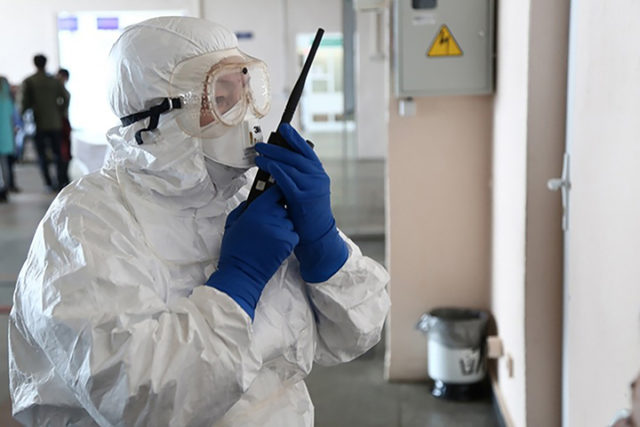
Coronavirus Hitting Russia East of the Urals Hard Economically but Not Yet Medically
Publication: Eurasia Daily Monitor Volume: 17 Issue: 34
By:

When the coronavirus outbreak in China’s Wuhan Province began late last year, many in Moscow and the West assumed that Siberia and the Russian Far East, which share more than 4,200 kilometers of common border with China and across which numerous traders pass every day, would be among the first places at risk for the spread of the infection. So far at least (based on the statistics released by Russian authorities), that has not been the case medically; but the measures taken against COVID-19 and the panic about the possible spread of the virus responsible have already had a serious impact on the economy of that enormously large but relatively underpopulated region.
The absence of reported coronavirus infections in Russia east of the Urals has inspired some to label Siberia as “the go-to place in the world” to avoid infection, Anna Liesowska of the The Siberian Times says; but it has also prompted many experts to question the official data showing that there are, as yet, only four cases in Siberia and the Far East, with at least one coming from Italy (The Siberian Times, March 14). Aleksandr Chepurnov, a leading specialist on infectious diseases at the Russian State Research Center on Virology and Biotechnology at Koltsovo, in Novosibirsk Oblast, told The Siberian Times that he is not “that sure that all is so safe here.”
“I cannot find any explanation” for the numbers,” the Russian epidemiologist cautioned; and “what is worrying is that I do not understand why [doctors and hospitals] do not take samples from all people with pneumonia.” Instead, they ascribe all these cases to “seasonal flu.” But this “looks rather strange: the part of the country that directly borders with China and with a large number of people that cross the borders” has such small numbers of infected. This is “quite surprising” (The Siberian Times, March 14).
It is certainly surprising in one way but perhaps not in another. In fact, although most of the Chinese in Russia east of the Urals are there as short-term transborder day traders (and are therefore likely potential carriers of the virus), Russian authorities have effectively stopped the flow of such people. Meanwhile, the smaller number of Chinese who are in the region more permanently (working in local industry or agriculture) in most cases work in self-imposed isolation and, thus, do not come into contact with the local population as frequently as might be expected (BBC News—Russian service, October 21, 2019; RBC, November 30, 2019).
As a result, the statistics Russian officials have announced in the region may be less distorted than many might assume despite Moscow’s history of misrepresentation. And Moscow may thus be able to take credit for its rapid response after the Wuhan outbreak. Early on, it blocked passenger trains from China and cross-border posts, and it imposed flight restrictions on Chinese passengers. At present, Chinese citizens are banned from entering the Russian Federation; however, officials are allowing all of those who want to go home to do so. No figures are yet available, but the number choosing to leave is clearly significant. And like their counterparts elsewhere in the world, Russian officials are promoting the use of online technologies for schools and workplaces in the Far East, distributing masks, and pursuing other steps to reduce the number of interpersonal contacts that could lead to the spread of the virus (Regnum, accessed March 17).
In some places like Vladivostok, for example, half of local employees are now working from home. Moreover, the region’s higher educational institutions have reportedly either shifted to distance learning or plan to within the next week or so. This change is also taking place in some primary and secondary schools but at a much slower pace because of the lack of technology (TASS, March 17).
Yet, even if the Russian government is actually being successful in containing the spread of the coronavirus in Siberia and the Russian Far East—a contention that some experts continue to doubt—it has not found a way to counter the large and damaging impact of panic about the disease. Nor have the authorities successfully mitigated the negative economic consequences of blocking Chinese visitors to the region. Some products that had been coming from China are in short supply, and prices have spiked. More seriously, the number of patrons of restaurants and hotels east of the Urals has fallen dramatically, in many cases by 20 percent or more, with the figures expected to worsen further in the coming weeks (EastRussia.ru, March 6).
Russian firms are losing money “on all fronts,” the EastRussia.ru portal asserts, with the effective end of tourism from China and its neighbors. Moscow has also banned the entrance of citizens of both Koreas, for example. In Khabarovsk, Vladivostok, Yuzhno-Sakhalinsk and Petrozavodsk-Kamchatsky, the hotels, restaurants and other establishments that have relied on the influx of foreign visitors are, therefore, all in trouble. Even after the COVID-19 crisis passes, owners and officials say, it is unclear when (if ever) these tourist flows might be restored to what they had been. Some say that they hope to instead promote tourism among fellow Russians; but that effort has squarely run up against calls by officials to self-isolate in order to prevent the spread of the virus.
In the short term, the measures the authorities have taken to contain the coronavirus are (inadvertently though probably necessarily) further depressing the economy in this enormous Russian region. But even after the crisis passes, the coronavirus outbreak will likely further add to eastern Russians’ fears about any Chinese presence (Kasparov.ru, June 27, 2016) and make the development of that region and of Moscow’s ties with Beijing even more difficult.



